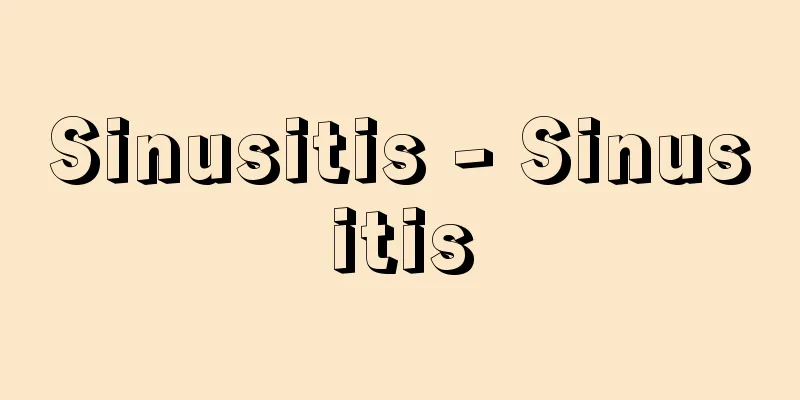Sinusitis - Sinusitis

|
A general term for inflammatory lesions of the paranasal sinuses. The paranasal sinuses are bone cavities that surround the nasal cavity from above to the outside, and consist of four: the maxillary sinus, the ethmoid sinus (ethmoid sinus honeycomb), the frontal sinus, and the sphenoid sinus. Each sinus communicates with the nasal cavity through a narrow tube or hole (natural hole). Inflammatory lesions of these sinuses are called sinusitis, and may be limited to a single sinus or may affect several sinuses at the same time. They are called by the name of the affected sinus, but sometimes all sinuses are affected, which is called generalized sinusitis. Sinusitis is broadly classified into acute, chronic, and barotropic sinusitis. [Masami Kawamura] Acute sinusitisIt often begins as a complication of a cold or allergic rhinitis. The inflammation spreads to the paranasal sinuses through the natural opening. Inflammation of the teeth can also cause maxillary sinusitis (odontogenic maxillary sinusitis). The natural opening narrows due to swelling of the mucous membrane caused by inflammation, making it difficult for secretions from inflammation in the sinus to be discharged, eventually leading to bacterial infection (suppurative sinusitis) and prolonged healing. Symptoms include fever, fatigue, pain or headache in the bone where the infected sinus is located, and in maxillary, ethmoid, and frontal sinusitis, tenderness and edema may be seen in the cheeks, root of the nose, and frontal sinus. Symptoms are more pronounced in children, and maxillary sinusitis in infants under 3 months of age is a type of maxillary osteomyelitis due to the underdevelopment of the maxillary sinus. Symptoms include sudden high fever, swelling of the cheeks, chemosis, and exophthalmos, and this condition is called neonatal maxillary sinusitis. Odontogenic maxillary sinusitis causes foul-smelling nasal discharge. Treatment mainly involves systemic administration of antibiotics, application of vasoconstrictors to the nose, cold compresses, and administration of analgesics for pain. Surgery is performed for neonatal maxillary sinusitis, while odontogenic maxillary sinusitis requires dental treatment. [Masami Kawamura] Chronic sinusitisMany cases of acute sinusitis do not heal completely and become chronic, so purulent sinusitis caused by bacterial infection is common. Because pus accumulates in the sinuses, it is sometimes called pyometra. Sometimes the sinuses are filled with a cheese-like substance (caseous sinusitis), which is common in elderly people and is caused by fungal infection. Symptoms vary in severity and nature, including nasal discharge, postnasal drip, nasal congestion, heavy head, headache, dull pain in the affected sinus, and loss of smell. Treatment involves the application of vasoconstrictors to the nose, sinus or nasal irrigation, and local or systemic administration of antibiotics and anti-inflammatory drugs. If nasal polyps are present, they should be removed before treatment. Sometimes radical surgery may be required. Chronic sinusitis in children has a good prognosis, with 50% of cases cured naturally by adolescence. [Masami Kawamura] Barotropic sinusitisThis condition occurs because the natural sinus openings become closed due to inflammation or nasal polyps when the air pressure suddenly changes during flying or diving due to the difference between the external air pressure and the pressure inside the sinuses. Many people contract this condition when they fly while suffering from a cold. When the aircraft descends or ascends, the patient feels intense pain in the forehead and cheeks, and the pain remains. Treatment involves applying a vasoconstrictor to the inside of the nose to open the natural sinus openings. As a preventative measure, people with a cold or upper respiratory tract inflammation, especially those with nasal polyps, should avoid flying. If healing is prolonged, bacterial infection may develop, progressing to purulent sinusitis. [Masami Kawamura] Source: Shogakukan Encyclopedia Nipponica About Encyclopedia Nipponica Information | Legend |
|
副鼻腔の炎症性病変の総称。副鼻腔は鼻腔を上から両外側を取り巻くように存在する骨の中の洞(どう)で、上顎(じょうがく)洞、篩骨(しこつ)洞(篩骨洞蜂巣(ほうそう))と、前頭洞、蝶形骨(ちょうけいこつ)洞の四つからなり、それぞれ鼻腔と狭い管または孔(あな)(自然孔(こう))で交通している。これらの洞の炎症性病変が副鼻腔炎であり、単一の洞に限られることもあるし、いくつかの洞がともに罹患(りかん)することもある。それぞれ罹患した洞の名称でよばれるが、ときにはすべての洞が侵され、これを汎(はん)副鼻腔炎という。大きく急性、慢性、気圧性の副鼻腔炎に分類される。 [河村正三] 急性副鼻腔炎鼻かぜやアレルギー性鼻炎の合併症として始まることが多い。炎症は自然孔を経て副鼻腔へ波及する。歯の炎症によって上顎洞炎がおこること(歯性上顎洞炎)もある。炎症による粘膜腫脹(しゅちょう)のために自然孔は狭くなり、洞内の炎症による分泌物は排出されにくく、やがて細菌の感染(化膿(かのう)性副鼻腔炎)をおこし、治癒が長引く。症状は発熱、倦怠(けんたい)感、感染した副鼻腔がある骨の疼痛(とうつう)ないし頭痛で、上顎洞炎、篩骨洞炎、前頭洞炎では頬(ほお)、鼻根部、前頭洞部に圧痛と浮腫を認めることがある。小児では症状がより著明で、生後3か月以内の乳児の上顎洞炎は上顎洞の発育が未発達のため、上顎骨骨髄炎の型となる。症状は突然の高熱、頬部(きょうぶ)腫脹、結膜浮腫、眼球突出などで、これを新生児上顎洞炎とよぶ。歯性上顎洞炎では悪臭のある鼻漏がみられる。治療は、全身的な抗生物質の投与、鼻内へ血管収縮剤などの塗布、冷罨法(あんぽう)、疼痛に対する鎮痛剤の投与が主となる。新生児上顎洞炎では手術が行われ、歯性上顎洞炎では歯の治療が必要である。 [河村正三] 慢性副鼻腔炎急性副鼻腔炎が完全に治癒せず慢性化したものが多いため、細菌感染による化膿性副鼻腔炎が多くみられる。洞内に膿が貯留しているので、蓄膿症と俗称されることがある。ときに洞の中がチーズ様の物質で充満されていること(乾酪(かんらく)性副鼻腔炎)があり、老人に多くみられ、真菌感染による。症状は鼻漏、後鼻漏、鼻閉、頭重感、頭痛、罹患した副鼻腔上の鈍痛、嗅覚(きゅうかく)脱失などで、その程度や性質は種々ある。治療は、鼻内へ血管収縮剤などの塗布、洞または鼻の洗浄、局所または全身的な抗生物質や抗炎症剤の投与を行うが、鼻茸(はなたけ)がある場合はその摘出を行ってから治療するのがよい。ときには根治的手術が必要なこともある。小児の慢性副鼻腔炎は予後がよく、思春期までに50%は自然治癒する。 [河村正三] 気圧性副鼻腔炎外界の気圧と副鼻腔内圧が異なることが原因で、飛行や潜水で気圧が急に変化したときに副鼻腔の自然孔が炎症や鼻茸などで閉鎖しているためにおこる。鼻かぜをひいているときに航空機に乗って罹患する例が多い。航空機が降下または上昇する際に前頭部や頬部に激しい疼痛を感じ、その疼痛が残存する。治療は、鼻内へ血管収縮剤などを塗布し、副鼻腔の自然孔を開放する。予防として、鼻かぜや上気道炎症、とくに鼻茸のある場合は飛行を避ける。治癒が長引くと、細菌感染をおこして化膿性副鼻腔炎に移行する。 [河村正三] 出典 小学館 日本大百科全書(ニッポニカ)日本大百科全書(ニッポニカ)について 情報 | 凡例 |
Recommend
Rudolf von Ems
…He avoided dialectal forms in rhyming, and contr...
Bandits - Bazoku
An armed group of horsemen that existed in northe...
Honors system - honors system
A system of special status given under national la...
Shikotansou - Shikotansou
A perennial plant of the Saxifragaceae family (AP...
Hydrofluoric acid (Hydrofluoric acid)
An aqueous solution of hydrogen fluoride (HF). Als...
Roof tile
During the Song Dynasty in China, these were ente...
sapta svara (English spelling) saptasvara
…However, in the case of laras sléndro, the scale...
Giant gourd ground beetle - Giant gourd ground beetle
...The Scaritidae family of beetles, as their nam...
Full
…an ethnic group living widely in West Africa. Th...
Malatesta
Italian anarchist. A disciple of Bakunin, he was o...
Ichikishiki Pottery
…It was discovered in 1921, and in 1961, full-sca...
computer network
A state in which multiple computers are connected ...
Celtae
…one of the ethnic groups that make up the histor...
Pacuvius, M.
…Livius Andronicus produced the first tragedies a...
Dientzenhofer, C.
…A family of late Baroque architects active in Ba...









